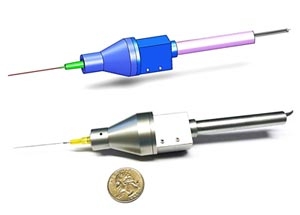
SMART microsurgery tools: CAD model, top, and prototype device (Cheol Song, Johns Hopkins University)
Researchers at the Johns Hopkins University medical school and engineering department in Baltimore developed surgical tools with an optical fiber sensor system that measures and corrects for minute hand tremors of even the most skilled surgeons. Engineering postdoctoral fellow Cheol Song and two Johns Hopkins colleagues describe the technology in the new issue of the online journal Optics Express, published by The Optical Society.
Even the steadiest of surgeons find their hands have minor tremors that can pose a serious risk for patients facing microsurgery on the eyes or nerve fibers. Song notes that “certain fine micro-manipulations remain beyond the motor control of even the most skilled surgeon,” with the human hand naturally trembling at some 50 to 100 microns — about the thickness of a sheet of paper — several times each second.
While some surgery technologies, including robotics, can minimize the effect of hand tremors, none are yet able to merge simple, fine-grained, and rapid fiber-optic sensing with hand held automated surgical tools. The key issue has been to precisely measure and compensate for the motions of a surgical instrument in relation to the target.
To meet this issue, Song and colleagues harnessed a fine-motion imaging technique known as optical coherence tomography as a distance measuring tool, and combined it with computer-controlled piezoelectric motors to stabilize the tip of surgical instruments. Optical coherence tomography is a desirable technology because of its higher resolution than either MRI or ultrasound, and its use near infrared light, which is safer for human eyes.
The researchers integrated a high-speed and precision sensor into a hand held surgical device, with a fiber-optic version of optical coherence tomography. This flavor of optical coherence tomography uses the same optical fiber circuit path to both transmit and receive near infrared light. The device is called Smart Micromanipulation Aided Robotic-surgical Tool, or SMART.
The need for only one optical fiber kept the system small and made it possible to integrate the fiber into the front of a tool used for eye surgery. The continuous sending and receiving the near infrared laser beams enables the high-speed fiber-optic sensor to precisely measure the motion of the probe.
These measurements are then fed into a computer that sends signals to the piezoelectric motors integrated into the surgical device that control the position of the tool tip. These control signals create a series of maneuvers that compensate for the surgeon’s hand tremors. The researchers found the sensor and motors could operate accurately at 500 hertz — 500 times each second — which is a higher frequency than the typical hand-tremor frequency of 0-15 hertz.
Song and colleagues tested the device on a dry target to simulate routine medical applications, as well as a chicken embryo, which provided more of a real-world microsurgery test. The live chicken embryo had unpredictable movements, which made it a better real-world test than the dry target.
The tests showed the device’s capability to compensate for hand tremors during 5- and 30-second intervals. The 30-second interval is “enough to evaluate a surgeon’s basic physiological hand tremor characteristics,” says Song, although testing will eventually need to be extended for a full three-hour surgical procedure.
Read more:
- Feasibility Demonstrated of Tiny Wireless Cardiac Implants
- Clinical Eye Testing Simulation Software Developed
- University Develops Surgical Blood Capture Device
- Hopkins Students Invent Suturing Device, Start Company
- Challenge Seeks Method to Connect Tissues Without Sutures
* * *

 RSS - Posts
RSS - Posts
You must be logged in to post a comment.